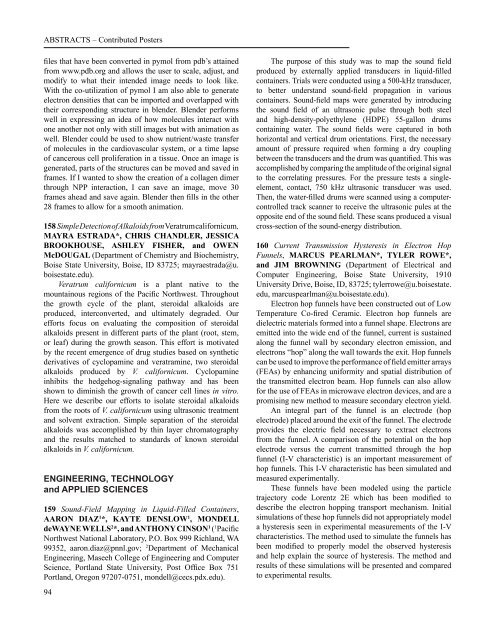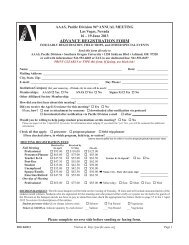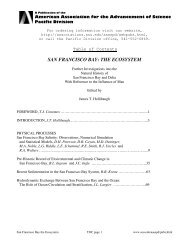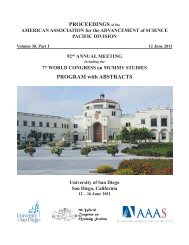Vol 31, Part I - forums.sou.edu ⢠Index page - Southern Oregon ...
Vol 31, Part I - forums.sou.edu ⢠Index page - Southern Oregon ...
Vol 31, Part I - forums.sou.edu ⢠Index page - Southern Oregon ...
You also want an ePaper? Increase the reach of your titles
YUMPU automatically turns print PDFs into web optimized ePapers that Google loves.
ABSTRACTS – Contributed Posters<br />
files that have been converted in pymol from pdb’s attained<br />
from www.pdb.org and allows the user to scale, adjust, and<br />
modify to what their intended image needs to look like.<br />
With the co-utilization of pymol I am also able to generate<br />
electron densities that can be imported and overlapped with<br />
their corresponding structure in blender. Blender performs<br />
well in expressing an idea of how molecules interact with<br />
one another not only with still images but with animation as<br />
well. Blender could be used to show nutrient/waste transfer<br />
of molecules in the cardiovascular system, or a time lapse<br />
of cancerous cell proliferation in a tissue. Once an image is<br />
generated, parts of the structures can be moved and saved in<br />
frames. If I wanted to show the creation of a collagen dimer<br />
through NPP interaction, I can save an image, move 30<br />
frames ahead and save again. Blender then fills in the other<br />
28 frames to allow for a smooth animation.<br />
158 Simple Detection of Alkaloids from Veratrum californicum,<br />
MAYRA ESTRADA*, CHRIS CHANDLER, JESSICA<br />
BROOKHOUSE, ASHLEY FISHER, and OWEN<br />
McDOUGAL (Department of Chemistry and Biochemistry,<br />
Boise State University, Boise, ID 83725; mayraestrada@u.<br />
boisestate.<strong>edu</strong>).<br />
Veratrum californicum is a plant native to the<br />
mountainous regions of the Pacific Northwest. Throughout<br />
the growth cycle of the plant, steroidal alkaloids are<br />
produced, interconverted, and ultimately degraded. Our<br />
efforts focus on evaluating the composition of steroidal<br />
alkaloids present in different parts of the plant (root, stem,<br />
or leaf) during the growth season. This effort is motivated<br />
by the recent emergence of drug studies based on synthetic<br />
derivatives of cyclopamine and veratramine, two steroidal<br />
alkaloids produced by V. californicum. Cyclopamine<br />
inhibits the hedgehog-signaling pathway and has been<br />
shown to diminish the growth of cancer cell lines in vitro.<br />
Here we describe our efforts to isolate steroidal alkaloids<br />
from the roots of V. californicum using ultrasonic treatment<br />
and solvent extraction. Simple separation of the steroidal<br />
alkaloids was accomplished by thin layer chromatography<br />
and the results matched to standards of known steroidal<br />
alkaloids in V. californicum.<br />
ENGINEERING, TECHNOLOGY<br />
and APPLIED SCIENCES<br />
159 Sound-Field Mapping in Liquid-Filled Containers,<br />
AARON DIAZ 1 *, KAYTE DENSLOW 1 , MONDELL<br />
deWAYNE WELLS 2 *, and ANTHONY CINSON 1 ( 1 Pacific<br />
Northwest National Laboratory, P.O. Box 999 Richland, WA<br />
99352, aaron.diaz@pnnl.gov; 2 Department of Mechanical<br />
Engineering, Maseeh College of Engineering and Computer<br />
Science, Portland State University, Post Office Box 751<br />
Portland, <strong>Oregon</strong> 97207-0751, mondell@cecs.pdx.<strong>edu</strong>).<br />
94<br />
The purpose of this study was to map the <strong>sou</strong>nd field<br />
produced by externally applied transducers in liquid-filled<br />
containers. Trials were conducted using a 500-kHz transducer,<br />
to better understand <strong>sou</strong>nd-field propagation in various<br />
containers. Sound-field maps were generated by introducing<br />
the <strong>sou</strong>nd field of an ultrasonic pulse through both steel<br />
and high-density-polyethylene (HDPE) 55-gallon drums<br />
containing water. The <strong>sou</strong>nd fields were captured in both<br />
horizontal and vertical drum orientations. First, the necessary<br />
amount of pressure required when forming a dry coupling<br />
between the transducers and the drum was quantified. This was<br />
accomplished by comparing the amplitude of the original signal<br />
to the correlating pressures. For the pressure tests a singleelement,<br />
contact, 750 kHz ultrasonic transducer was used.<br />
Then, the water-filled drums were scanned using a computercontrolled<br />
track scanner to receive the ultrasonic pules at the<br />
opposite end of the <strong>sou</strong>nd field. These scans produced a visual<br />
cross-section of the <strong>sou</strong>nd-energy distribution.<br />
160 Current Transmission Hysteresis in Electron Hop<br />
Funnels, MARCUS PEARLMAN*, TYLER ROWE*,<br />
and JIM BROWNING (Department of Electrical and<br />
Computer Engineering, Boise State University, 1910<br />
University Drive, Boise, ID, 83725; tylerrowe@u.boisestate.<br />
<strong>edu</strong>, marcuspearlman@u.boisestate.<strong>edu</strong>).<br />
Electron hop funnels have been constructed out of Low<br />
Temperature Co-fired Ceramic. Electron hop funnels are<br />
dielectric materials formed into a funnel shape. Electrons are<br />
emitted into the wide end of the funnel, current is sustained<br />
along the funnel wall by secondary electron emission, and<br />
electrons “hop” along the wall towards the exit. Hop funnels<br />
can be used to improve the performance of field emitter arrays<br />
(FEAs) by enhancing uniformity and spatial distribution of<br />
the transmitted electron beam. Hop funnels can also allow<br />
for the use of FEAs in microwave electron devices, and are a<br />
promising new method to measure secondary electron yield.<br />
An integral part of the funnel is an electrode (hop<br />
electrode) placed around the exit of the funnel. The electrode<br />
provides the electric field necessary to extract electrons<br />
from the funnel. A comparison of the potential on the hop<br />
electrode versus the current transmitted through the hop<br />
funnel (I-V characteristic) is an important measurement of<br />
hop funnels. This I-V characteristic has been simulated and<br />
measured experimentally.<br />
These funnels have been modeled using the particle<br />
trajectory code Lorentz 2E which has been modified to<br />
describe the electron hopping transport mechanism. Initial<br />
simulations of these hop funnels did not appropriately model<br />
a hysteresis seen in experimental measurements of the I-V<br />
characteristics. The method used to simulate the funnels has<br />
been modified to properly model the observed hysteresis<br />
and help explain the <strong>sou</strong>rce of hysteresis. The method and<br />
results of these simulations will be presented and compared<br />
to experimental results.








